What To See In Positano, Italy
What to see in Positano in Italy.
Perched dramatically on the cliffs of Italy's Amalfi Coast, Positano is arguably one of the most photographed villages in the world, and for good reason. This vertical town cascades down the mountainside like a colorful waterfall, with its pastel-colored houses, lemon groves, and stunning Mediterranean views creating a picture-perfect scene that'll have you reaching for your camera every few steps.
Located on the southern coast of the Sorrentine Peninsula in the Campania region, Positano sits about 50 kilometers southeast of Naples. The town is built into the steep cliffs overlooking the Tyrrhenian Sea, making it one of the most dramatic coastal settlements you'll ever encounter. It's part of the famous Amalfi Coast, a UNESCO World Heritage site that's been captivating visitors for centuries.
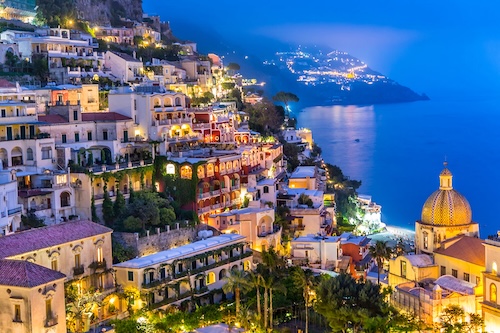 Positano in the evening
Positano in the evening
What To See In Positano
When it comes to how to get to Positano, you've got several options depending on where you're starting from. The most common route is flying into Naples International Airport, then taking the Curreri bus directly to Positano (about 1.5 hours) or catching a train to Sorrento and then the SITA bus along the coastal road.
If you're feeling adventurous and your budget allows, consider taking a ferry from Naples, Sorrento, or other coastal towns – the approach by sea offers absolutely breathtaking views of the coastline.
Driving to Positano is possible but honestly, I wouldn't recommend it unless you're very comfortable with narrow, winding mountain roads and limited parking.
The SS163 coastal road is stunning but can be nerve-wracking, especially during peak season when it's packed with buses and other tourists. Plus, parking in Positano is extremely limited and expensive, so you're better off using public transport.
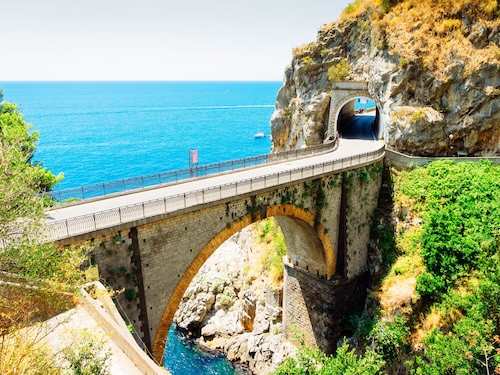 A bridge on the SS163
A bridge on the SS163The heart of what to see in Positano starts with simply wandering its steep, narrow streets. The town is essentially one big staircase, with the main pedestrian street, Via dei Mulini, winding down from the upper town to the beach.
Every turn reveals another Instagram-worthy view, whether it's colorful houses tumbling down the cliff face, glimpses of the sparkling sea, or charming little shops tucked into ancient stone buildings.
Spiaggia Grande is Positano's main beach and the town's social hub. This pebbly stretch of coastline is where all the action happens – it's lined with colorful beach clubs, restaurants, and bars, all set against the dramatic backdrop of the town rising up the cliff behind.
While it gets crowded during peak season, there's something magical about sipping a spritz while watching the sunset paint the houses in golden light.
 Spiaggia grande
Spiaggia grandeThe beach clubs at Spiaggia Grande are worth experiencing at least once, even if they're pricey. Places like Bagni d'Arienzo and Le Tre Sorelle offer comfortable loungers, umbrellas, and beachside service, but expect to pay premium prices for the privilege.
If you're on a budget, there are small sections of free beach, though you'll need to arrive early to snag a good spot.
For a more secluded beach experience, take the path down to Fornillo Beach, about a 10-minute walk west of Spiaggia Grande. This smaller, quieter beach has a more local feel and is perfect if you want to escape the crowds.
The walk there along the coastal path offers some of the best views of Positano from below, and you'll often have dolphins for company in the waters offshore.
The Chiesa di Santa Maria Assunta, with its iconic majolica-tiled dome, is probably Positano's most recognizable landmark. This 13th-century church sits right in the town center and houses a beautiful Byzantine icon of the Virgin Mary, known as the Black Madonna. The church's bell tower and colorful dome have become symbols of Positano, appearing in countless photos and postcards.
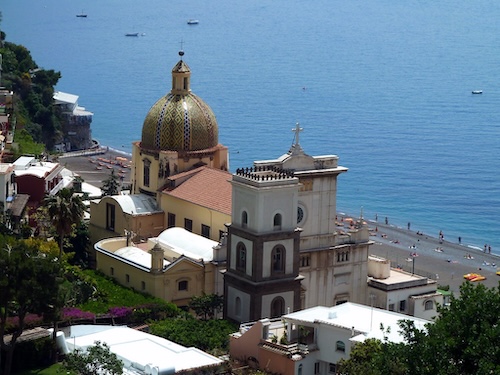 Chiesa di Santa Maria Assunta
Chiesa di Santa Maria AssuntaInside the church, don't miss the wooden crucifix above the altar and the beautiful floor tiles. The church also hosts concerts during the summer months, and attending one is a magical experience with the sound echoing off the ancient walls. The small piazza in front of the church is a great spot for people-watching and often hosts local events and festivals.
What To See In Positano
One of the most rewarding things to do in Positano is hiking the Path of the Gods (Sentiero degli Dei). This ancient footpath connects Positano to other towns along the coast and offers some of the most spectacular views in all of Italy. The trail runs along the ridge above the coast, giving you bird's-eye views of the entire Amalfi Coast stretching out below.
The most popular section of the Path of the Gods runs from Bomerano to Nocelle (a hamlet above Positano), taking about 2-3 hours. From Nocelle, you can either walk down to Positano (another hour of steep steps) or take the local bus.
The trail is well-marked but can be challenging, so wear good hiking shoes and bring plenty of water. The views are absolutely worth the effort – you'll see why this coastline has inspired artists and writers for generations.
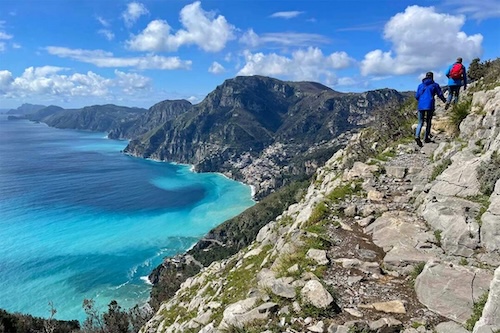 Path of the Gods
Path of the GodsFor a unique perspective on Positano, consider taking a boat tour along the coast. These excursions offer views of the town that you simply can't get from land, showing how dramatically it clings to the cliff face. Many tours also include stops at hidden beaches and sea caves, plus the chance to swim in crystal-clear waters away from the crowded main beaches.
The boat tours often include visits to nearby attractions like the Emerald Grotto (Grotta dello Smeraldo) or the island of Capri.
Our trusted partner, Viator, does a great trip! See below....
Small-Group Amalfi Coast Day Cruise from Positano
Get an intimate look at the stunning Amalfi Coast on this day cruise from Positano. Led by an expert skipper, glide past the Emerald Grotto sea cave in Conca dei Marini, the Furore fjord, and the fishing village of Praiano, marveling at the UNESCO-listed seashore as you go.
Hop off the boat for a dip or some time to snorkel, and explore the town of Ravello or Amalfi at your leisure. Numbers are limited to 12 people on this small-group tour to ensure a more personal experience.
Read more about and book here - Small-Group Amalfi Coast Day Cruise from Positano
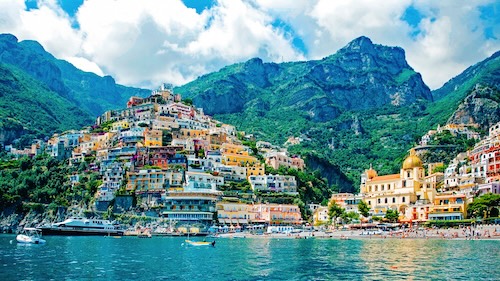 Positano from the sea
Positano from the seaShopping in Positano is all about local crafts and fashion. The town is famous for its handmade sandals – places like Safari and Da Costanzo have been crafting custom leather sandals for decades.
They'll measure your feet and create a pair just for you, usually ready within a few hours. These aren't cheap, but they're incredibly well-made and become more comfortable with wear.
Positano is also known for its lemon products and limoncello. The lemons grown on the terraced hillsides around town are huge and incredibly fragrant, used to make everything from limoncello to lemon soap and perfumes.
Stop by shops like Sapori e Profumi di Positano to sample and buy authentic local products. The ceramics here are also beautiful, with many pieces hand-painted in traditional Mediterranean designs.
What To See In Positano
When it comes to dining, Positano offers everything from casual beachside trattorias to Michelin-starred restaurants. For a special occasion, book a table at La Sponda in Le Sirenuse hotel – the candlelit terrace offers incredible views and exceptional food, though you'll pay accordingly. The restaurant is famous for its romantic atmosphere, with hundreds of candles creating a magical ambiance.
For more casual but still excellent dining, try Da Adolfo, accessible only by boat or a steep hike down from the main road. This rustic beach restaurant serves simple, fresh seafood with your toes in the sand. Their mozzarella is legendary – it's delivered fresh daily from a local farm and served with just tomatoes and basil. Book ahead and arrange boat transport from Spiaggia Grande.
 Da Adolfo restaurant
Da Adolfo restaurantIl Ritrovo, located in the upper part of town, offers fantastic food with a more local atmosphere and reasonable prices. The family-run restaurant serves traditional dishes with a modern twist, and their terrace has beautiful views over the coast. It's popular with both locals and tourists who've discovered this gem away from the main tourist drag.
 Il Ritrovo
Il RitrovoFor coffee and pastries, start your day at Bar Internazionale, right in the heart of town. Their cornetti (Italian croissants) are freshly baked each morning, and the coffee is excellent. The outdoor seating gives you a front-row seat to watch Positano wake up. Another great spot is Collina Bakery, which serves fantastic bread and pastries with a view.
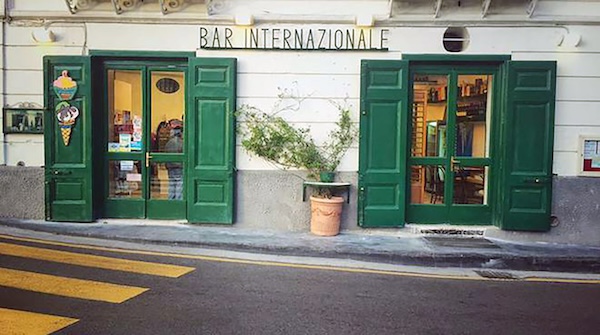 Bar Internazionale
Bar InternazionaleWhen the sun goes down, head to Franco's Bar for aperitivo with a view. This tiny bar carved into the cliff face offers some of the best sunset views in town, though space is limited so arrive early. Their Aperol Spritz is perfectly mixed, and the atmosphere is unbeatable. Just be prepared for a steep climb to get there!
Music on the Rocks is Positano's most famous nightclub, built into a natural cave on the beach. It's been a fixture of the town's nightlife since the 1970s and attracts both locals and visitors with its unique setting and good music.
The club doesn't get going until late (midnight or later), and drinks are expensive, but the experience of dancing in a cave by the sea is pretty unforgettable.
 Torre Trasita
Torre TrasitaTopTip: visit the Torre Trasita, a 16th-century watchtower that's now a private residence but offers incredible photo opportunities. It's located on the path between Positano and Fornillo Beach, and while you can't go inside, the views from around the tower are spectacular and much less crowded than other viewpoints.
Another local secret is the early morning fish market near the beach. If you're up early (around 6-7 AM), you can watch the local fishermen bring in their catch and see the restaurants selecting the freshest fish for the day. It's a glimpse into the working life of the town that most visitors never see.
The best viewpoint for photos is from the terrace of the Hotel Poseidon, even if you're not staying there. The hotel welcomes non-guests to enjoy a drink on their terrace, which offers the classic postcard view of Positano's colorful houses cascading down to the sea. Go for sunset and order a cocktail – it's worth the splurge for the view.
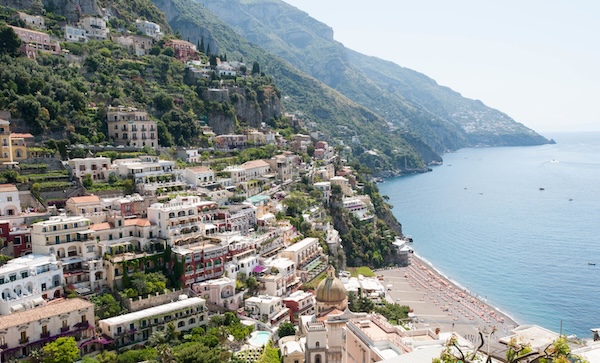 View from the Hotel Poseidon
View from the Hotel PoseidonWhat to see in Positano
Timing your visit is crucial for enjoying Positano without the overwhelming crowds. The absolute best time is late April to early June, when the weather is warm but not scorching, and the summer crowds haven't arrived yet. September is also excellent – the sea is still warm from summer, but the crowds are thinning out.
July and August are the busiest and most expensive months, with temperatures often exceeding 30°C (86°F). Crowds make movement through the narrow streets difficult. If you must visit during peak season, stay overnight rather than day-tripping – the town is much more pleasant in the early morning and evening when the day-trippers have left.
Winter (November through March) is the quietest time, but many restaurants and hotels close, and the weather can be unpredictable. However, if you don't mind cooler temperatures and the possibility of rain, you'll have the town almost to yourself, and accommodation prices drop significantly.
Speaking of accommodation, the big question many visitors face is whether to stay overnight in Positano or make it a day trip from elsewhere. If your budget allows, definitely stay at least one night. The town transforms after the day-trippers leave – it becomes peaceful, romantic, and much more authentic. You'll also have time to explore the hiking trails and enjoy leisurely meals without rushing.
If you're on a tighter budget, consider staying in nearby Sorrento or Amalfi and taking day trips to Positano. Sorrento offers more accommodation options at various price points and better transport connections, while still giving you easy access to Positano via the SITA bus (about 50 minutes) or ferry services during summer.
For those staying in Positano, book accommodation well in advance, especially for summer visits. The town has limited lodging options, ranging from luxury hotels like Le Sirenuse and Il San Pietro to smaller boutique properties and B&Bs. Many of the best places are built into the cliff face, offering incredible views but requiring some climbing to reach.
A final insider tip: download the Positano shuttle bus app or ask locals about the internal bus service. These small buses run regularly between the upper and lower parts of town, saving your legs from the constant climbing. They're inexpensive and a godsend when you're tired from walking the steep streets all day.
What to see in Positano ultimately comes down to embracing the town's unique rhythm and spectacular setting. Whether you're sipping limoncello on a terrace overlooking the sea, hiking the ancient paths above the coast, or simply wandering the colorful streets with no particular destination in mind, Positano offers experiences that will stay with you long after you leave.






